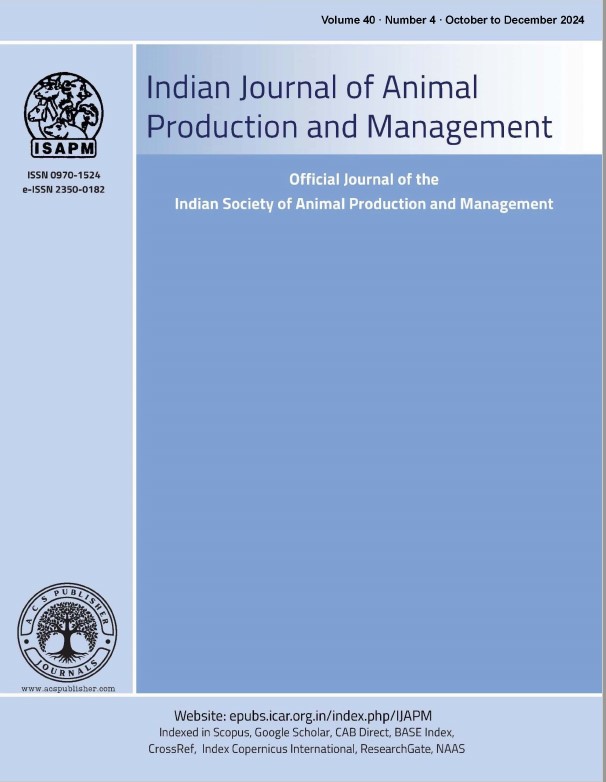Management Interventions to Reduce Incidence of Diarrhoea in Piglets during Pre Weaning Period
DOI:
https://doi.org/10.48165/ijapm.2024.40.2.9Keywords:
piglets, pre-weaning diarrhoea, teat dipping, floor moppingAbstract
A study was carried out at an organized pig farm in Kalyani, West Bengal, to assess effectiveness of management practices like teat dipping and floor mopping on reduction of bacterial load and diarrhoeal incidence during pre-weaning period in piglets. Twenty lactating sows of Ghoongroo breed along with their newborn piglets (146 nos.) during pre-weaning period were studied. In group 1 (control) floor of each farrowing pen was washed with normal water. In group 2, additionally teats of each sow were treated with 10% povidone iodine dip. In group 3 floor of each farrowing pen was washed with normal water followed by mopping with 0.25% potassium permanganate. In group 4 both sow teat dipping and sty floor mopping with disinfectant was done. It was observed that the average bacterial load during the total pre-weaning period of 8 weeks was 48.4x103± 5.3 x103 cfu/cm2 in control group, whereas the average bacterial load was 34.0 x103±1.2X103 and 7.18 x102±0.10 x102 cfu/cm2 before and after teat dip application in group 2, and 32.5 x103±1.3 x103 cfu/cm2 and 6.98 x102±0.11 x102 cfu/cm2 in group 4, respectively, indicating positive impact of teat dipping as well as disinfectant floor mopping in reducing the bacterial loads of sow teats. Regular teat dipping and sty floor mopping can improve the body growth of piglets, by reducing the occurrence of piglet diarrhoea. Thus, the chances of economic losses in pig production unit can be reduced.
References
Chae C, Kwon D, Kim O, Min K, Cheon D S, Choi C, Kim B and Suh J (1998). Diarrhoea in nursing piglets associated with coccidiosis: prevalence, microscopic lesions and coexisting microorganisms. Veterinary
Record, 143(15):417-420.
Divyalakshmi D, Kumaravelu N, Ronald M, Devi T, Muthuramalingam and Gnanaraj PT (2016). Comparison of Floor Microbial Load in Different Systems of Floorings in Livestock Sheds. Asian
Australian Journal Animal Science, 23:1614- 1625.
Divyalakshmi D, Kumaravelu N, Vanan T T and Gnanaraj PT (2018). Comparison of Floor Microbial Load in Different types of rabbit cages. Journal of Applied and Natural Science, 10(4):1226-1229.
Galton D M, Petersson L G and Erb H N (1986). Milk iodine residues in herds practicing iodophor pre milking teat disinfection. Journal of Dairy Science, 69(1): 267-271.
Gibson H, Sinclair L A, Brizuela C M, Worto H L and Protheroe R G (2008). Effectiveness of selected premilking teat-cleaning regimes in reducing teat microbial load on commercial dairy farms. The Society for Applied Microbiology, 46:295-300.
Gospodarek-Komkowska E (2019). Comparison of the effectiveness of dipping agents on bacteria causing mastitis in cattle. Annals of Agricultural and Environmental Medicine, 26(1): 39-45.
Gupta R N, Parmar S N S and Johar K S (1982). Note on the study of litter size at birth and weaning in Large White Yorkshire pigs. Indian Journal of Animal Sciences, 52(11): 1138-1139
Lakhani G P and Nema R K (1989). Study on birth weight and weaning weight in indigenous pigs. Indian Journal of Animal Research, 23(1): 13-15.
Ostović M, Pavičić Ž, Tofant A, Balenović T, Kabalin A E, Menčik S and Marković F (2010). Teat sanitation in lactating sows. Acta Veterinaria, 60(2-3):249-256.
Roberts L, Walker E J, Snodgrass D R and Angus K W (1980). Diarrhoea in unweaned piglets
Sarkar et al.
associated with rotavirus and coccidial infections. Veterinary Record, 107(7):156-157.
Snedecor G W and Cochran W G (1989). Statistical Methods. 8th Edition, Iowa State University Press, Ames.
Subramanya S H, Pai V, Bairy I, Nayak N, Gokhale S, and Santhian B (2018). Potassium permanganate cleansing is an effective sanitary method for the reduction of bacterial bioload on
raw Corriander sativum. BMC Research Notes, 11(1):124.
Suriyasathaporn W and Chupia V (2011). Reduction in numbers of bacteria after pre milking teat dipping in milking dairy cows. Chiang Mai University Journal of Natural Science, 10(2): 301-306.

